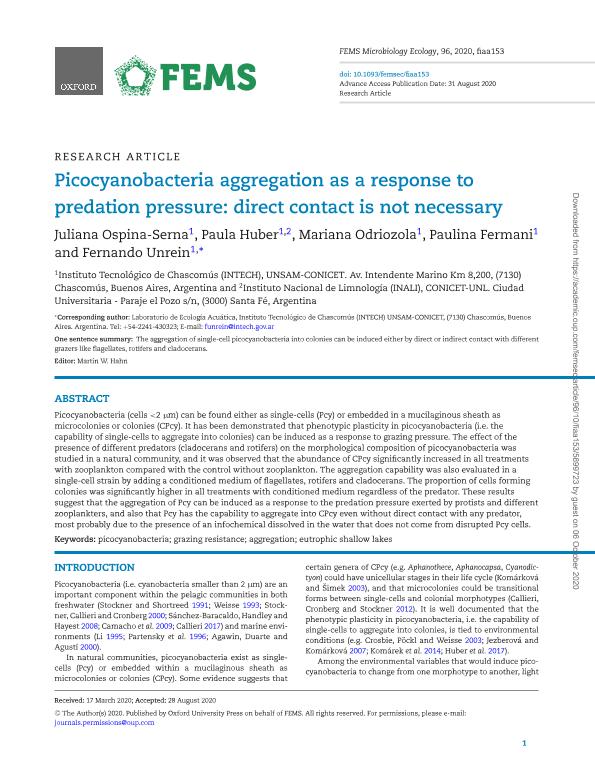Mostrar el registro sencillo del ítem
dc.contributor.author
Ospina Serna, Juliana Andrea

dc.contributor.author
Huber, Maria Paula

dc.contributor.author
Odriozola, Mariana Paola

dc.contributor.author
Fermani, Paulina

dc.contributor.author
Unrein, Fernando

dc.date.available
2022-06-06T14:05:27Z
dc.date.issued
2020-08
dc.identifier.citation
Ospina Serna, Juliana Andrea; Huber, Maria Paula; Odriozola, Mariana Paola; Fermani, Paulina; Unrein, Fernando; Picocyanobacteria aggregation as a response of predation pressure: The direct contact is not necessary; Wiley Blackwell Publishing, Inc; Fems Microbiology Ecology; 96; 10; 8-2020; 1-10
dc.identifier.issn
0168-6496
dc.identifier.uri
http://hdl.handle.net/11336/159003
dc.description.abstract
Picocyanobacteria (cells <2 µm) can be found either as single-cells (Pcy) or embedded in a mucilaginous sheath as microcolonies or colonies (CPcy). It has been demonstrated that phenotypic plasticity in picocyanobacteria (i.e. the capability of single-cells to aggregate into colonies) can be induced as a response to grazing pressure. The effect of the direct contact of different predators (cladocerans and rot2ifers) over the morphological composition of picocyanobacteria were studied in a natural community, and it was observed that the abundance of CPcy significantly increased in all treatments with zooplankton respect to the control. The aggregation capability was also evaluated in a single-32 cell strain, by adding conditioned medium of flagellates, rotifers and cladocerans. The proportion of cells forming colonies was significantly higher in all treatments with conditioned medium regardless the predator. These results suggest that the aggregation of Pcy can be induce as a response of the predation pressure exerted by protists and different zooplankters, and also that Pcy has the capability to aggregate into CPcy even without a direct contact with any predator, most probably due to the presence of an infochemical dissolved into the water that would not came from disrupted Pcy cells.
dc.format
application/pdf
dc.language.iso
eng
dc.publisher
Wiley Blackwell Publishing, Inc

dc.rights
info:eu-repo/semantics/openAccess
dc.rights.uri
https://creativecommons.org/licenses/by-nc-sa/2.5/ar/
dc.subject
PICOCYANOBACTERIA
dc.subject
GRAZING RESISTANCE
dc.subject
AGGREGATOIN
dc.subject
EUTROPHIC SHALLOW LAKE
dc.subject.classification
Biología Marina, Limnología

dc.subject.classification
Ciencias Biológicas

dc.subject.classification
CIENCIAS NATURALES Y EXACTAS

dc.title
Picocyanobacteria aggregation as a response of predation pressure: The direct contact is not necessary
dc.type
info:eu-repo/semantics/article
dc.type
info:ar-repo/semantics/artículo
dc.type
info:eu-repo/semantics/publishedVersion
dc.date.updated
2022-04-26T20:25:57Z
dc.identifier.eissn
1574-6941
dc.journal.volume
96
dc.journal.number
10
dc.journal.pagination
1-10
dc.journal.pais
Reino Unido

dc.journal.ciudad
Londres
dc.description.fil
Fil: Ospina Serna, Juliana Andrea. Consejo Nacional de Investigaciones Científicas y Técnicas. Centro Científico Tecnológico Conicet - La Plata. Instituto de Investigaciones Biotecnológicas. Instituto de Investigaciones Biotecnológicas "Dr. Raúl Alfonsín" (sede Chascomús). Universidad Nacional de San Martín. Instituto de Investigaciones Biotecnológicas. Instituto de Investigaciones Biotecnológicas "Dr. Raúl Alfonsín" (sede Chascomús); Argentina
dc.description.fil
Fil: Huber, Maria Paula. Consejo Nacional de Investigaciones Científicas y Técnicas. Centro Científico Tecnológico Conicet - La Plata. Instituto de Investigaciones Biotecnológicas. Instituto de Investigaciones Biotecnológicas "Dr. Raúl Alfonsín" (sede Chascomús). Universidad Nacional de San Martín. Instituto de Investigaciones Biotecnológicas. Instituto de Investigaciones Biotecnológicas "Dr. Raúl Alfonsín" (sede Chascomús); Argentina. Consejo Nacional de Investigaciones Científicas y Técnicas. Centro Científico Tecnológico Conicet - Santa Fe. Instituto Nacional de Limnología. Universidad Nacional del Litoral. Instituto Nacional de Limnología; Argentina
dc.description.fil
Fil: Odriozola, Mariana Paola. Consejo Nacional de Investigaciones Científicas y Técnicas. Centro Científico Tecnológico Conicet - La Plata. Instituto de Investigaciones Biotecnológicas. Instituto de Investigaciones Biotecnológicas "Dr. Raúl Alfonsín" (sede Chascomús). Universidad Nacional de San Martín. Instituto de Investigaciones Biotecnológicas. Instituto de Investigaciones Biotecnológicas "Dr. Raúl Alfonsín" (sede Chascomús); Argentina
dc.description.fil
Fil: Fermani, Paulina. Consejo Nacional de Investigaciones Científicas y Técnicas. Centro Científico Tecnológico Conicet - La Plata. Instituto de Investigaciones Biotecnológicas. Instituto de Investigaciones Biotecnológicas "Dr. Raúl Alfonsín" (sede Chascomús). Universidad Nacional de San Martín. Instituto de Investigaciones Biotecnológicas. Instituto de Investigaciones Biotecnológicas "Dr. Raúl Alfonsín" (sede Chascomús); Argentina
dc.description.fil
Fil: Unrein, Fernando. Consejo Nacional de Investigaciones Científicas y Técnicas. Centro Científico Tecnológico Conicet - La Plata. Instituto de Investigaciones Biotecnológicas. Instituto de Investigaciones Biotecnológicas "Dr. Raúl Alfonsín" (sede Chascomús). Universidad Nacional de San Martín. Instituto de Investigaciones Biotecnológicas. Instituto de Investigaciones Biotecnológicas "Dr. Raúl Alfonsín" (sede Chascomús); Argentina
dc.journal.title
Fems Microbiology Ecology

dc.relation.alternativeid
info:eu-repo/semantics/altIdentifier/url/https://academic.oup.com/femsec/article/96/10/fiaa153/5899723
dc.relation.alternativeid
info:eu-repo/semantics/altIdentifier/doi/http://dx.doi.org/10.1093/femsec/fiaa153
Archivos asociados
